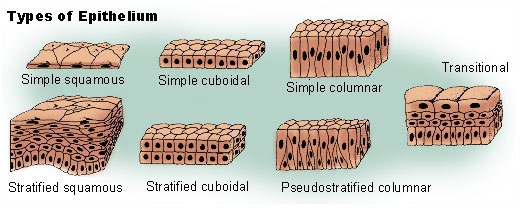EPITHELIAL TISSUE
EPITHELIAL TISSUE KEY FACTS
- Epithelial tissue is composed of cells laid together in sheets with the cells tightly connected to one another. Epithelial layers are avascular, but innervated.
- Epithelial cells have two surfaces that differ in both structure and function.
- Glands, such as exocrine and endocrine, are composed of epithelial tissue and classified based on how their secretions are released.
Functions of the Epithelium
Epithelia tissue forms boundaries between different environments, and nearly all substances must pass through the epithelium. In its role as an interface tissue, epithelium accomplishes many functions, including:
- Protection for the underlying tissues from radiation, desiccation, toxins, and physical trauma.
- Absorption of substances in the digestive tract lining with distinct modifications.
- Regulation and excretion of chemicals between the underlying tissues and the body cavity.
- The secretion of hormones into the blood vascular system. The secretion of sweat, mucus, enzymes, and other products that are delivered by ducts come from the glandular epithelium.
- The detection of sensation.
Characteristics of Epithelial Layers
Epithelial tissue is composed of cells laid out in sheets with strong cell-to-cell attachments. These protein connections hold the cells together to form a tightly connected layer that is avascular but innervated in nature.
The epithelial cells are nourished by substances diffusing from blood vessels in the underlying connective tissue. One side of the epithelial cell is oriented towards the surface of the tissue, body cavity, or external environment and the other surface is joined to a basement membrane. The basement layer is non-cellular in nature and helps to cement the epithelial tissue to the underlying structures.
Types of Epithelial Tissue
Epithelial tissues are identified by both the number of layers and the shape of the cells in the upper layers. There are eight basic types of epithelium: six of them are identified based on both the number of cells and their shape; two of them are named by the type of cell (squamous) found in them. Epithelial tissue is classified based on the number of cells, the shape of those cells, and the types of those cells.

Comentarios
Publicar un comentario